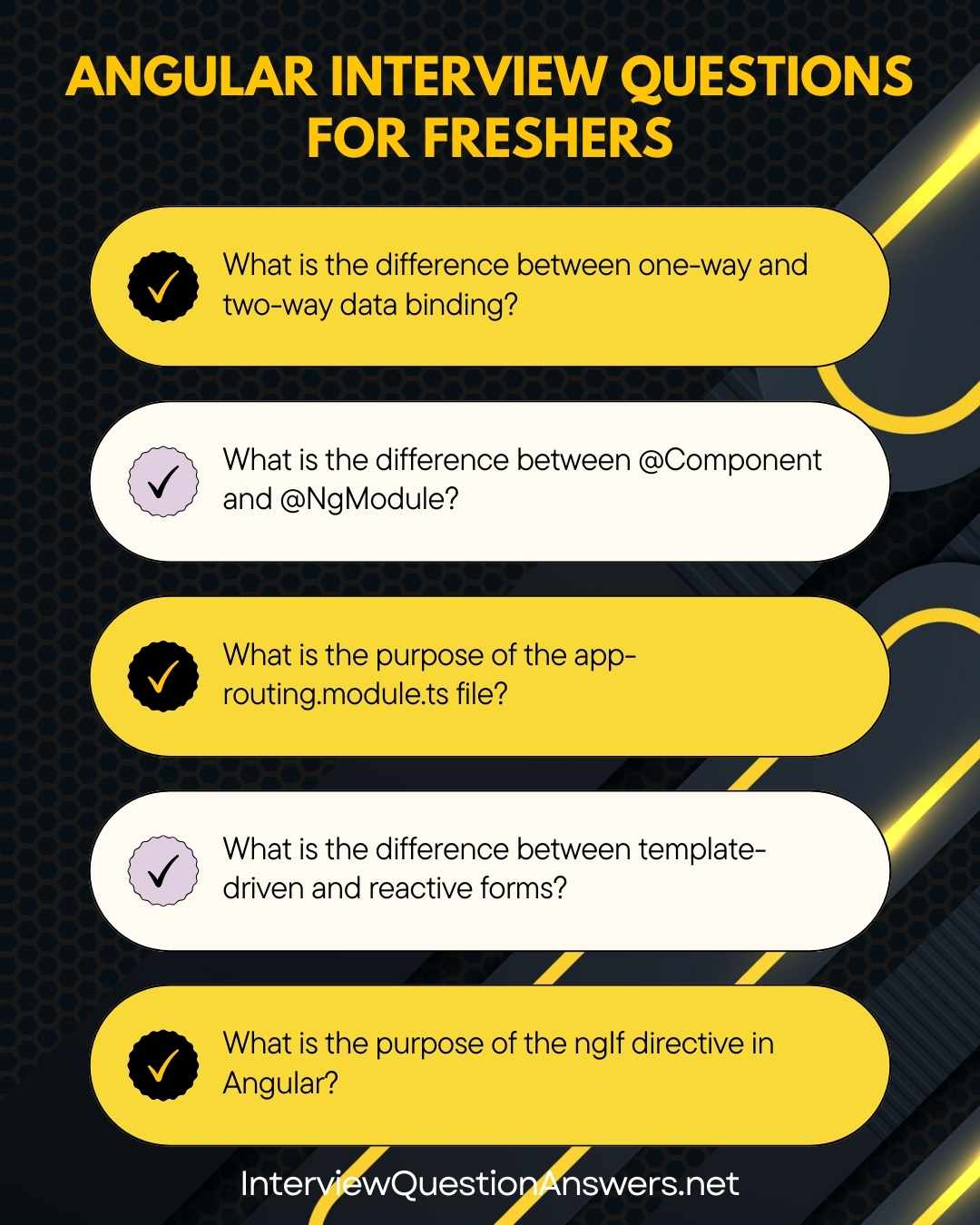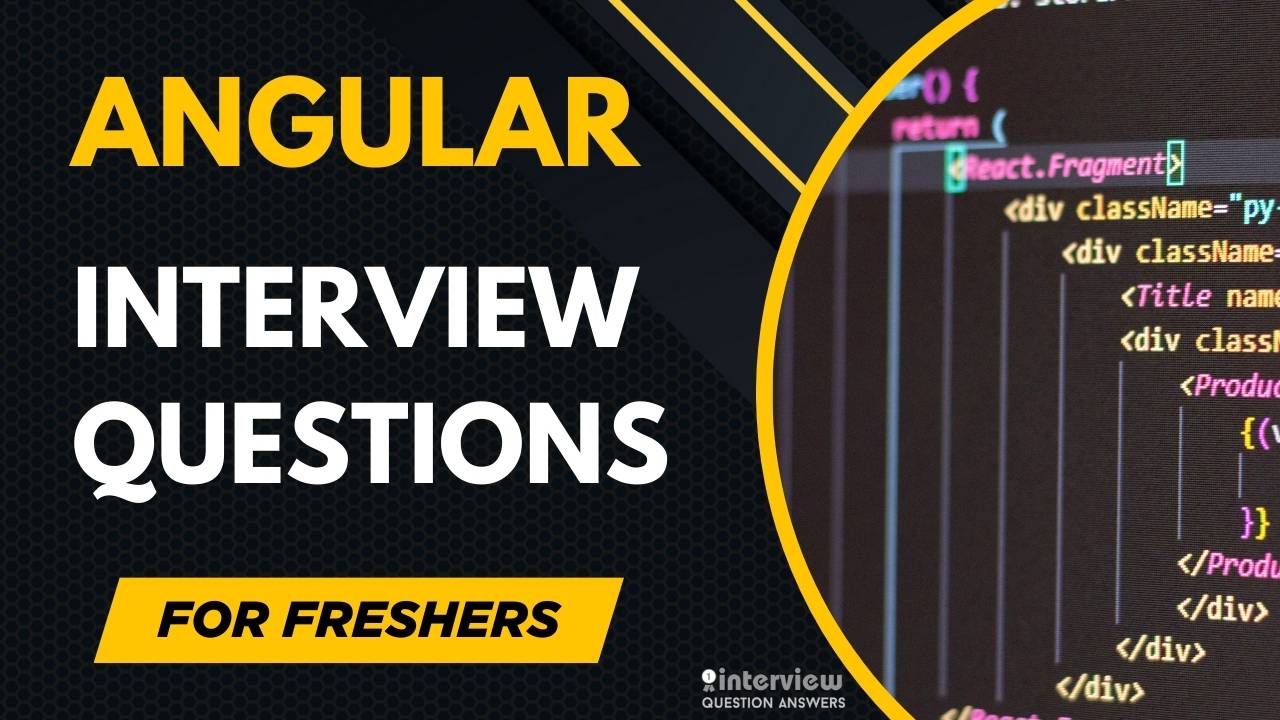Top 60 Angular Interview Questions for Freshers
This guide helps you master core Angular concepts such as Modules, Components, Data Binding, Directives, and Dependency Injection while also exploring more advanced topics like Angular CLI, RxJS, and Observables. By practicing both conceptual and scenario-based questions, you can confidently handle technical discussions in interviews.
With businesses adopting single-page applications (SPAs) and modern front-end frameworks rapidly, learning Angular best practices, performance optimization techniques, and real-world problem-solving skills gives you a competitive edge.
You can also check our detailed guide: Top 100 Angular interview Questions and Answers PDF
Table of Contents
Entry Level Angular Interview Questions and Answers
Que 1. What is Angular, and how does it differ from AngularJS?
Answer:
Angular is a TypeScript-based framework for building dynamic web applications, maintained by Google. Unlike AngularJS (version 1.x), which uses JavaScript and controllers, Angular uses components, TypeScript, and a more structured architecture with dependency injection and reactive programming.
Que 2. What is a component in Angular?
Answer:
A component is a building block of an Angular application, consisting of a TypeScript class, an HTML template, and CSS styles. It controls a part of the UI and its behavior.
import { Component } from '@angular/core';
@Component({
selector: 'app-my-component',
template: '<h1>Hello, Angular!</h1>',
styles: ['h1 { color: blue; }']
})
export class MyComponent {}Que 3. What is the purpose of the app.module.ts file?
Answer:
The app.module.ts file is the root module of an Angular application. It declares components, imports other modules, and configures the app’s bootstrap process.
import { NgModule } from '@angular/core';
import { BrowserModule } from '@angular/platform-browser';
import { AppComponent } from './app.component';
@NgModule({
declarations: [AppComponent],
imports: [BrowserModule],
bootstrap: [AppComponent]
})
export class AppModule {}Que 4. How do you create a new component in Angular?
Answer:
Use the Angular CLI command ng generate component <name> to create a component with its template, styles, and TypeScript files.
ng generate component my-component// my-component.component.ts
import { Component } from '@angular/core';
@Component({
selector: 'app-my-component',
templateUrl: './my-component.component.html'
})
export class MyComponent {}Que 5. What is data binding in Angular?
Answer:
Data binding connects a component’s data to its template. Types include one-way ({{}}, [], ()), and two-way ([(ngModel)]) binding.
<input [value]="name" (input)="name = $event.target.value">Que 6. What is the difference between one-way and two-way data binding?
Answer:
One-way binding updates the view from the component ({{}}, []) or handles events (()). Two-way binding syncs data between component and view, commonly with ngModel.
<input [(ngModel)]="name">export class MyComponent {
name: string = '';
}Que 7. What is a directive in Angular?
Answer:
Directives are classes that add behavior to elements. Types include component directives, attribute directives (e.g., ngClass), and structural directives (e.g., *ngIf).
<div *ngIf="isVisible">Show me!</div>Que 8. How do you handle user input in Angular?
Answer:
Use event binding ((event)="handler()") or two-way binding with ngModel to capture and process user input.
<input (input)="onInput($event)" [(ngModel)]="userInput">export class MyComponent {
userInput: string = '';
onInput(event: Event) {
console.log((event.target as HTMLInputElement).value);
}
}Que 9. What is the purpose of the ngOnInit lifecycle hook?
Answer:ngOnInit is a lifecycle hook called after Angular initializes a component’s data-bound properties. It’s used for setup tasks like fetching data.
import { Component, OnInit } from '@angular/core';
export class MyComponent implements OnInit {
ngOnInit() {
console.log('Component initialized');
}
}Que 10. How do you create a service in Angular?
Answer:
Use the Angular CLI command ng generate service <name> to create a service for reusable logic, injectable via dependency injection.
ng generate service my-serviceimport { Injectable } from '@angular/core';
@Injectable({
providedIn: 'root'
})
export class MyService {
getData() {
return ['Item 1', 'Item 2'];
}
}Que 11. What is dependency injection in Angular?
Answer:
Dependency injection (DI) provides instances of services to components or other services, promoting modularity and testability. Services are injected via constructor parameters.
export class MyComponent {
constructor(private myService: MyService) {}
}Que 12. How do you make an HTTP request in Angular?
Answer:
Use the HttpClient module to make HTTP requests, typically in a service, handling responses with Observables.
import { HttpClient } from '@angular/common/http';
import { Injectable } from '@angular/core';
@Injectable({
providedIn: 'root'
})
export class DataService {
constructor(private http: HttpClient) {}
getUsers() {
return this.http.get('https://api.example.com/users');
}
}Que 13. What is the purpose of *ngFor directive?
Answer:
The *ngFor directive iterates over a collection to render a template for each item, used for lists or tables.
<ul>
<li *ngFor="let item of items">{{ item }}</li>
</ul>export class MyComponent {
items = ['A', 'B', 'C'];
}Que 14. What is the difference between @Component and @NgModule?
Answer:@Component defines a UI component with a template and logic. @NgModule defines a module, grouping components, services, and other modules for modularity.
Que 15. How do you navigate between routes in Angular?
Answer:
Use the Router service or routerLink directive to navigate between routes defined in the routing module.
<a routerLink="/dashboard">Go to Dashboard</a>import { Router } from '@angular/router';
export class MyComponent {
constructor(private router: Router) {}
navigate() {
this.router.navigate(['/dashboard']);
}
}Que 16. What is the purpose of the app-routing.module.ts file?
Answer:
The app-routing.module.ts file defines routes for the application, mapping URLs to components for navigation.
import { NgModule } from '@angular/core';
import { RouterModule, Routes } from '@angular/router';
import { HomeComponent } from './home.component';
const routes: Routes = [
{ path: 'home', component: HomeComponent }
];
@NgModule({
imports: [RouterModule.forRoot(routes)],
exports: [RouterModule]
})
export class AppRoutingModule {}Que 17. How do you create a pipe in Angular?
Answer:
Use the Angular CLI command ng generate pipe <name> to create a pipe for transforming data in templates.
ng generate pipe my-pipeimport { Pipe, PipeTransform } from '@angular/core';
@Pipe({ name: 'myPipe' })
export class MyPipe implements PipeTransform {
transform(value: string): string {
return value.toUpperCase();
}
}<p>{{ 'hello' | myPipe }}</p> <!-- Outputs: HELLO -->Que 18. What is the purpose of FormsModule in Angular?
Answer:FormsModule enables template-driven forms, providing directives like ngModel for two-way data binding and form validation.
import { FormsModule } from '@angular/forms';
@NgModule({
imports: [FormsModule]
})
export class AppModule {}Que 19. How do you handle errors in an HTTP request in Angular?
Answer:
Use the catchError operator from RxJS to handle errors in HTTP requests, displaying user-friendly messages.
import { HttpClient } from '@angular/common/http';
import { catchError } from 'rxjs/operators';
import { throwError } from 'rxjs';
export class DataService {
constructor(private http: HttpClient) {}
getUsers() {
return this.http.get('https://api.example.com/users')
.pipe(catchError(error => {
console.error('Error:', error);
return throwError('Failed to fetch users');
}));
}
}Que 20. What is the difference between template-driven and reactive forms?
Answer:
Template-driven forms use directives like ngModel in the template, ideal for simple forms. Reactive forms use FormGroup and FormControl in the component for programmatic control, better for complex forms with validation.
// Reactive form
import { FormGroup, FormControl } from '@angular/forms';
export class MyComponent {
form = new FormGroup({
name: new FormControl('')
});
}<form [formGroup]="form">
<input formControlName="name">
</form>
Also Check: Angular Interview Questions for Experienced
Most Common Angular Interview Questions for Freshers
Que 21. What is the purpose of the ngIf directive in Angular?
Answer:
The *ngIf directive conditionally includes or removes an element from the DOM based on a boolean expression, used to show or hide UI elements.
<div *ngIf="isVisible">Content shown</div>export class MyComponent {
isVisible = true;
}Que 22. How do you create a custom directive in Angular?
Answer:
Use the Angular CLI command ng generate directive <name> to create a directive, applying custom behavior to elements using the @Directive decorator.
ng generate directive highlightimport { Directive, ElementRef } from '@angular/core';
@Directive({
selector: '[appHighlight]'
})
export class HighlightDirective {
constructor(el: ElementRef) {
el.nativeElement.style.backgroundColor = 'yellow';
}
}<div appHighlight>Highlighted text</div>Que 23. What is the role of NgModule in Angular?
Answer:NgModule organizes an Angular app into cohesive blocks, declaring components, importing dependencies, and exporting reusable modules. The root module bootstraps the app.
import { NgModule } from '@angular/core';
import { BrowserModule } from '@angular/platform-browser';
import { AppComponent } from './app.component';
@NgModule({
declarations: [AppComponent],
imports: [BrowserModule],
bootstrap: [AppComponent]
})
export class AppModule {}Que 24. How do you pass data from a parent component to a child component?
Answer:
Use the @Input decorator to pass data from a parent to a child component via property binding.
// Child component
import { Component, Input } from '@angular/core';
@Component({
selector: 'app-child',
template: '<p>{{ data }}</p>'
})
export class ChildComponent {
@Input() data: string = '';
}<!-- Parent component -->
<app-child [data]="parentData"></app-child>export class ParentComponent {
parentData = 'Hello from parent';
}Que 25. How do you emit an event from a child component to a parent component?
Answer:
Use the @Output decorator with an EventEmitter to emit custom events from a child to a parent component.
// Child component
import { Component, Output, EventEmitter } from '@angular/core';
@Component({
selector: 'app-child',
template: '<button (click)="sendEvent()">Click me</button>'
})
export class ChildComponent {
@Output() myEvent = new EventEmitter<string>();
sendEvent() {
this.myEvent.emit('Event triggered');
}
}<!-- Parent component -->
<app-child (myEvent)="handleEvent($event)"></app-child>export class ParentComponent {
handleEvent(value: string) {
console.log(value);
}
}Que 26. What is the purpose of Angular CLI?
Answer:
Angular CLI is a command-line tool for creating, building, and managing Angular projects. It simplifies tasks like generating components, services, and modules.
ng new my-app
ng generate component my-componentQue 27. How do you handle form validation in Angular?
Answer:
Use reactive forms with Validators for programmatic validation or template-driven forms with directives like required. Display errors using form controls.
// Reactive form
import { FormGroup, FormControl, Validators } from '@angular/forms';
export class MyComponent {
form = new FormGroup({
email: new FormControl('', [Validators.required, Validators.email])
});
}<form [formGroup]="form">
<input formControlName="email">
<div *ngIf="form.get('email')?.hasError('required')">Email is required</div>
</form>Que 28. What is an Observable in Angular, and how is it used?
Answer:
An Observable is a reactive programming construct from RxJS, used to handle asynchronous data streams like HTTP requests or events. Subscribe to Observables to process data.
import { HttpClient } from '@angular/common/http';
export class MyComponent {
constructor(private http: HttpClient) {
this.http.get('https://api.example.com/data').subscribe(data => {
console.log(data);
});
}
}Que 29. How do you create a route guard in Angular?
Answer:
Implement CanActivate to control access to routes, creating a guard with Angular CLI to protect navigation.
ng generate guard authimport { Injectable } from '@angular/core';
import { CanActivate, Router } from '@angular/router';
@Injectable({
providedIn: 'root'
})
export class AuthGuard implements CanActivate {
constructor(private router: Router) {}
canActivate(): boolean {
if (/* user is authenticated */) return true;
this.router.navigate(['/login']);
return false;
}
}const routes: Routes = [{ path: 'protected', component: ProtectedComponent, canActivate: [AuthGuard] }];Que 30. What is the difference between providedIn: ‘root’ and module-specific providers?
Answer:providedIn: 'root' makes a service singleton across the app. Module-specific providers limit the service to a specific module, allowing multiple instances.
@Injectable({
providedIn: 'root'
})
export class MyService {}Que 31. How do you use pipes to transform data in Angular?
Answer:
Pipes transform data in templates, like formatting dates or currency. Use built-in pipes or create custom ones with @Pipe.
<p>{{ today | date:'short' }}</p>export class MyComponent {
today = new Date();
}Que 32. What is the purpose of the async pipe in Angular?
Answer:
The async pipe subscribes to an Observable or Promise, automatically updating the view with the emitted value and handling unsubscription.
<div>{{ data$ | async }}</div>export class MyComponent {
data$ = this.http.get('https://api.example.com/data');
constructor(private http: HttpClient) {}
}Que 33. How do you lazy-load a module in Angular?
Answer:
Lazy-load modules by defining routes with loadChildren to load modules only when accessed, improving performance.
const routes: Routes = [
{ path: 'lazy', loadChildren: () => import('./lazy/lazy.module').then(m => m.LazyModule) }
];Que 34. What is the difference between ngOnInit and ngAfterViewInit?
Answer:ngOnInit runs after component initialization for setup tasks. ngAfterViewInit runs after the component’s view and child views are fully initialized, ideal for view-related logic.
export class MyComponent implements OnInit, AfterViewInit {
ngOnInit() { console.log('Initialized'); }
ngAfterViewInit() { console.log('View ready'); }
}Que 35. How do you handle HTTP errors in Angular?
Answer:
Use catchError from RxJS in a service to handle HTTP errors, returning user-friendly messages or fallback data.
import { HttpClient } from '@angular/common/http';
import { catchError } from 'rxjs/operators';
import { throwError } from 'rxjs';
@Injectable()
export class DataService {
constructor(private http: HttpClient) {}
getData() {
return this.http.get('https://api.example.com/data')
.pipe(catchError(error => throwError('Error fetching data')));
}
}Que 36. What is the purpose of trackBy in *ngFor?
Answer:trackBy optimizes *ngFor by identifying items uniquely, reducing DOM updates for better performance.
<li *ngFor="let item of items; trackBy: trackById">{{ item.name }}</li>export class MyComponent {
items = [{ id: 1, name: 'A' }, { id: 2, name: 'B' }];
trackById(index: number, item: any) {
return item.id;
}
}Que 37. How do you create a reactive form in Angular?
Answer:
Use FormGroup and FormControl from @angular/forms to create a reactive form, defining validation programmatically.
import { FormGroup, FormControl, Validators } from '@angular/forms';
export class MyComponent {
form = new FormGroup({
name: new FormControl('', Validators.required)
});
}<form [formGroup]="form">
<input formControlName="name">
</form>Que 38. What is Angular’s change detection, and how does it work?
Answer:
Change detection updates the DOM when component data changes. Angular uses zone.js to detect changes automatically, comparing component state to trigger updates.
Que 39. How do you use a service to share data between components?
Answer:
Create a service with a shared data source (e.g., BehaviorSubject) and inject it into components to share and update data.
@Injectable({
providedIn: 'root'
})
export class DataService {
private dataSubject = new BehaviorSubject<string>('Initial');
data$ = this.dataSubject.asObservable();
updateData(value: string) {
this.dataSubject.next(value);
}
}Que 40. How do you test an Angular component?
Answer:
Use Jasmine and TestBed to test components. Configure the testing module, create the component, and test its behavior.
import { ComponentFixture, TestBed } from '@angular/core/testing';
import { MyComponent } from './my.component';
describe('MyComponent', () => {
let fixture: ComponentFixture<MyComponent>;
beforeEach(() => {
TestBed.configureTestingModule({ declarations: [MyComponent] });
fixture = TestBed.createComponent(MyComponent);
});
it('should create', () => {
expect(fixture.componentInstance).toBeTruthy();
});
});Advanced Angular Interview Questions for Freshers
Que 41. How do you implement lazy loading in Angular to improve performance?
Answer:
Lazy loading delays loading of feature modules until their routes are accessed. Configure routes with loadChildren in the routing module, reducing initial bundle size.
const routes: Routes = [
{ path: 'feature', loadChildren: () => import('./feature/feature.module').then(m => m.FeatureModule) }
];// feature.module.ts
@NgModule({
declarations: [FeatureComponent],
imports: [CommonModule, RouterModule.forChild([{ path: '', component: FeatureComponent }])]
})
export class FeatureModule {}Que 42. How do you optimize Angular change detection for large applications?
Answer:
Use ChangeDetectionStrategy.OnPush to limit change detection to input changes or manual triggers. Avoid complex computations in templates and use async pipe to manage subscriptions.
@Component({
selector: 'app-my-component',
template: '<div>{{ data }}</div>',
changeDetection: ChangeDetectionStrategy.OnPush
})
export class MyComponent {
@Input() data: string;
constructor(private cdr: ChangeDetectorRef) {}
}Que 43. How do you implement a custom pipe with parameters in Angular?
Answer:
Create a pipe with @Pipe and implement PipeTransform. Accept parameters in the transform method for dynamic transformations.
@Pipe({ name: 'multiply' })
export class MultiplyPipe implements PipeTransform {
transform(value: number, factor: number): number {
return value * factor;
}
}<p>{{ 5 | multiply:2 }}</p> <!-- Outputs: 10 -->Que 44. How do you handle authentication in an Angular application?
Answer:
Use a service to manage authentication tokens, store them in localStorage or cookies, and implement an AuthGuard to protect routes. Intercept requests with HttpInterceptor to add tokens.
@Injectable()
export class AuthInterceptor implements HttpInterceptor {
intercept(req: HttpRequest<any>, next: HttpHandler) {
const token = localStorage.getItem('token');
const authReq = req.clone({ setHeaders: { Authorization: `Bearer ${token}` } });
return next.handle(authReq);
}
}Que 45. How do you implement server-side rendering (SSR) in Angular?
Answer:
Use Angular Universal to render Angular apps on the server. Add @angular/platform-server and configure server.ts to pre-render pages for SEO and faster initial loads.
// server.ts
import { enableProdMode } from '@angular/core';
import { renderModule } from '@angular/platform-server';
import { AppServerModule } from './src/main.server';
enableProdMode();
renderModule(AppServerModule, { document: '<app-root></app-root>' });Que 46. How do you use RxJS operators to handle complex data streams in Angular?
Answer:
Use operators like map, filter, switchMap, and combineLatest to transform and combine Observables for complex async operations.
import { combineLatest } from 'rxjs';
export class MyComponent {
constructor(private service: DataService) {
combineLatest([this.service.getUsers(), this.service.getOrders()])
.pipe(map(([users, orders]) => ({ users, orders })))
.subscribe(data => console.log(data));
}
}Que 47. How do you implement a route resolver in Angular?
Answer:
Create a resolver with Resolve to fetch data before activating a route, ensuring data is available when the component loads.
@Injectable({ providedIn: 'root' })
export class DataResolver implements Resolve<any> {
constructor(private service: DataService) {}
resolve() {
return this.service.getData();
}
}const routes: Routes = [
{ path: 'data', component: DataComponent, resolve: { data: DataResolver } }
];Que 48. How do you create a reusable component library in Angular?
Answer:
Create a separate module for components, use Angular CLI to generate a library (ng generate library), and publish it to npm. Import the library in other projects.
ng generate library my-lib// my-lib.module.ts
@NgModule({
declarations: [ReusableComponent],
exports: [ReusableComponent]
})
export class MyLibModule {}Que 49. How do you handle forms with dynamic controls in Angular?
Answer:
Use FormArray in reactive forms to manage dynamic form controls, adding or removing controls programmatically.
export class MyComponent {
form = new FormGroup({
items: new FormArray([])
});
addItem() {
(this.form.get('items') as FormArray).push(new FormControl(''));
}
}<form [formGroup]="form">
<div formArrayName="items">
<input *ngFor="let control of form.get('items').controls; let i=index" [formControlName]="i">
</div>
</form>Que 50. How do you implement state management in Angular with NgRx?
Answer:
Use NgRx to manage state with actions, reducers, and selectors. Define a store, dispatch actions, and select state for reactive updates.
// actions
export const loadData = createAction('[Data] Load');
export const dataLoaded = createAction('[Data] Loaded', props<{ data: any }>());
// reducer
export const reducer = createReducer(
initialState,
on(dataLoaded, (state, { data }) => ({ ...state, data }))
);
// selector
export const selectData = createSelector(state => state.data, data => data);Que 51. How do you optimize Angular apps for SEO?
Answer:
Use Angular Universal for server-side rendering to generate static HTML. Add meta tags with @angular/platform-browser and ensure routes are crawlable.
import { Meta, Title } from '@angular/platform-browser';
export class MyComponent {
constructor(private meta: Meta, private title: Title) {
this.title.setTitle('My App');
this.meta.addTag({ name: 'description', content: 'My app description' });
}
}Que 52. How do you handle internationalization (i18n) in Angular?
Answer:
Use Angular’s i18n tools to mark translatable text with i18n attributes and extract translations with ng xi18n. Serve locale-specific bundles with ng serve --configuration.
<h1 i18n="@@welcome">Welcome to my app</h1>ng xi18n --output-path src/localeQue 53. How do you implement unit testing for Angular components?
Answer:
Use Jasmine and TestBed to test components, mocking dependencies and testing inputs, outputs, and DOM interactions.
import { ComponentFixture, TestBed } from '@angular/core/testing';
import { MyComponent } from './my.component';
describe('MyComponent', () => {
let fixture: ComponentFixture<MyComponent>;
beforeEach(() => {
TestBed.configureTestingModule({ declarations: [MyComponent] });
fixture = TestBed.createComponent(MyComponent);
});
it('should render title', () => {
fixture.componentInstance.title = 'Test';
fixture.detectChanges();
expect(fixture.nativeElement.querySelector('h1').textContent).toContain('Test');
});
});Que 54. How do you handle HTTP request retries in Angular?
Answer:
Use RxJS retry and catchError operators to retry failed HTTP requests and handle errors gracefully.
import { HttpClient } from '@angular/common/http';
import { retry, catchError } from 'rxjs/operators';
export class DataService {
constructor(private http: HttpClient) {}
getData() {
return this.http.get('https://api.example.com/data')
.pipe(retry(3), catchError(() => throwError('Failed after retries')));
}
}Que 55. How do you implement a custom validator in Angular reactive forms?
Answer:
Create a function that returns a validator object, checking form control values for custom validation logic.
function customValidator(control: AbstractControl): ValidationErrors | null {
return control.value.length < 5 ? { tooShort: true } : null;
}
export class MyComponent {
form = new FormGroup({
name: new FormControl('', customValidator)
});
}<div *ngIf="form.get('name').hasError('tooShort')">Name too short</div>Que 56. How do you use Angular’s HttpClient with interceptors for logging?
Answer:
Implement an HttpInterceptor to log requests and responses, adding it to the app module’s providers.
@Injectable()
export class LoggingInterceptor implements HttpInterceptor {
intercept(req: HttpRequest<any>, next: HttpHandler) {
console.log('Request:', req.url);
return next.handle(req).pipe(tap(response => console.log('Response:', response)));
}
}@NgModule({
providers: [{ provide: HTTP_INTERCEPTORS, useClass: LoggingInterceptor, multi: true }]
})
export class AppModule {}Que 57. How do you implement dynamic components in Angular?
Answer:
Use ViewContainerRef and ComponentFactoryResolver to dynamically create and render components at runtime.
@Component({
selector: 'app-dynamic',
template: '<ng-container #container></ng-container>'
})
export class DynamicComponent {
@ViewChild('container', { read: ViewContainerRef }) container: ViewContainerRef;
constructor(private resolver: ComponentFactoryResolver) {}
createComponent() {
const factory = this.resolver.resolveComponentFactory(MyDynamicComponent);
this.container.createComponent(factory);
}
}Que 58. How do you handle cross-component communication without services?
Answer:
Use @Input and @Output for parent-child communication, or leverage Angular’s ViewChild/ContentChild to access child components directly.
@Component({
selector: 'app-parent',
template: '<app-child #child></app-child>'
})
export class ParentComponent {
@ViewChild('child') child: ChildComponent;
callChildMethod() {
this.child.someMethod();
}
}Que 59. How do you implement Angular animations?
Answer:
Use @angular/animations to define transitions and states, applying them to elements with triggers in the component.
import { trigger, state, style, transition, animate } from '@angular/animations';
@Component({
selector: 'app-my-component',
animations: [
trigger('fade', [
state('void', style({ opacity: 0 })),
transition(':enter, :leave', [animate('300ms')])
])
],
template: '<div [@fade]>Content</div>'
})
export class MyComponent {}Que 60. How do you integrate WebSocket in Angular for real-time updates?
Answer:
Use WebSocket or libraries like ngx-socket-io to connect to a WebSocket server, subscribing to messages for real-time UI updates.
import { webSocket } from 'rxjs/webSocket';
export class MyComponent {
subject = webSocket('ws://api.example.com');
constructor() {
this.subject.subscribe(msg => console.log('Message:', msg));
}
}Conclusion
We have already shared the questions for Angular Interview Questions for Freshers, covering basic concepts, core fundamentals, and beginner-friendly scenario-based questions to help you prepare effectively. This Angular Interview Questions for Freshers Guide gives you a strong foundation in Angular while ensuring you stay updated with the latest practices in front-end development.
As the web development industry continues to embrace Angular, React, and other modern frameworks, freshers who stay updated on Angular CLI, TypeScript, and real-world application development will have a significant advantage. Use this guide to sharpen your Angular skills, gain confidence, and step into your first interview well-prepared.
Similar Interview Guides:













